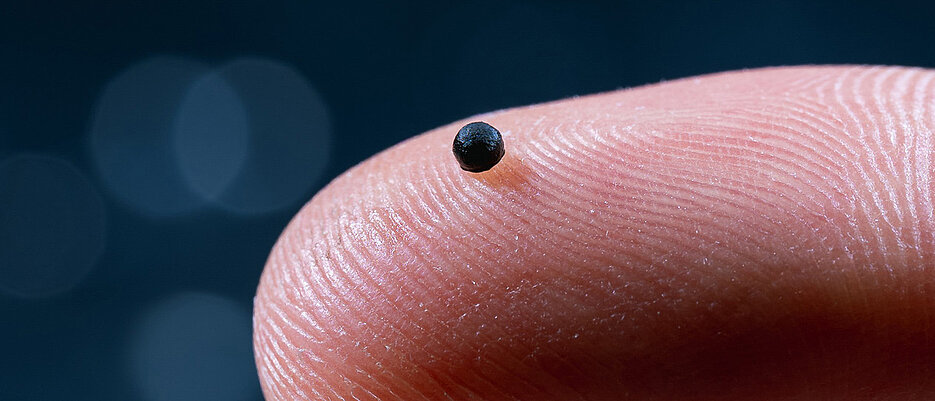A microrobot that delivers drugs precisely to their target location in the body and is soon to be clinically available: researchers at the University of Würzburg have contributed to this development by ETH Zurich.

A stroke occurs when blood clots block the vessels that supply the brain with blood. Twelve million people worldwide suffer a stroke every year - many die or are left with disabilities, such as paralysis.
To dissolve blood clots, drugs are currently administered that are distributed throughout the body. A high dose must be given to ensure that the necessary amount of the drug reaches the clot. However, this can have significant side effects, such as internal bleeding.
Delivering Drugs Precisely to the Site of Action
Drugs are often only needed at a specific site in the body. That is why medical research has long been trying to deliver them precisely to where they are needed - in the case of a stroke, directly to the vicinity of the blood clot.
A team from ETH Zurich has now achieved decisive breakthroughs on several levels in pursuit of this goal. The results have been published in the prestigious journal Science.
The authors of the publication include Professor Tessa Lühmann from the Institute of Pharmacy and Food Chemistry at Julius-Maximilians-Universität Würzburg (JMU).
Magnetically Controllable Microrobot Developed
For the targeted transport of drugs, the researchers are relying on a microrobot - a spherical capsule developed by themselves. It consists of a dissolvable gel shell and iron oxide nanoparticles. These make it possible to control the microrobot magnetically through the body.
'Because the vessels in the human brain are so small, the capsule must also be of a certain size. The technical challenge is that such a small capsule must also have sufficiently strong magnetic properties,' explains Fabian Landers, first author of the paper and postdoctoral researcher at the Multi-Scale Robotics Lab at ETH Zurich.
In order for doctors to be able to track how the capsule moves through the vessels using X-ray imaging, a contrast agent is required for the robot to be used. The researchers used tantalum nanoparticles, which are frequently used in medicine, for this purpose.
'Combining magnetic functionality, imaging visibility and precise control in a single microrobot requires perfect interaction between materials science and robotics. It took us many years to achieve this goal,' says ETH Professor Bradley Nelson. The group led by Professor Salvador Pané, a chemist at the Institute of Robotics and Intelligent Systems, developed tailor-made iron oxide nanoparticles for this purpose.
Microrobots Loaded With Common Drugs
The researchers succeeded in loading the microrobots with common drugs for various applications. These included a drug that dissolves blood clots, an antibiotic and an anti-tumour agent. The drugs are released by a high-frequency magnetic field that heats the magnetic nanoparticles and dissolves the gel shell and the microrobot.
The drug used to dissolve blood clots is an enzyme approved by the U.S. Food and Drug Administration (FDA) called tissue plasminogen activator (tPA).
'Proteins such as tPA are very sensitive. They have a complex, three-dimensional structure that must be folded very precisely for the molecule to function properly,' explains Tessa Lühmann. Even small changes in the environment - such as excessive temperatures, an incorrect pH value or long storage - could destroy this structure: 'The enzyme then loses its activity or may even clump together.'
Extensive Testing at the University of Würzburg
In order to better handle and target the use of tPA, the microrobots were extensively tested at the Institute of Pharmacy and Food Chemistry at the University of Würzburg for their compatibility with biological systems, as well as for the activity of the enzymes they contain and their stability during storage.
The Würzburg group focused in particular on the targeted transport of the active ingredient.
The gel shell of the microrobots is dissolved in the body by a controlled increase in temperature. However, this poses a risk to the stability of the enzymes. 'The big challenge was to find exactly the right temperature range in which the capsule disintegrates but the sensitive tPA retains its structure and effectiveness,' says the JMU professor. The team succeeded in doing this through extensive research.
Not Only Applicable for Vascular Occlusions
The new microrobots could be used not only against blood clots, but also for localised infections or tumours. At every stage of development, the research team has taken into account that everything it develops can be used in the operating theatre as soon as possible. The next goal is to begin clinical trials in humans as soon as possible.
Further Information
Interested parties can find further technical details on the use of micro-robots in the ETH Zurich press release .
Publication
Landers F, Hertle L, Pustovalov V et al.: Clinically ready magnetic microrobots for targeted therapies. Science (2025), DOI:10.1126/science.adx1708






